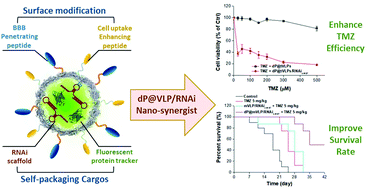Bioengineering fluorescent virus-like particle/RNAi nanocomplexes act synergistically with temozolomide to eradicate brain tumors†
Abstract
The proof-of-concept strategy in this study based on biodegradable and biocompatible self-assembling fluorescent virus-like particle/RNAi nanocomplexes (VLP/RNAi) produced in Escherichia coli (E. coli) followed by surface modification with a cell-penetrating peptide (CPP) and an apolipoprotein E peptide (ApoEP) (dP@VLP/RNAi), which can cross the blood–brain barrier (BBB) to inhibit the DNA repair mechanism and act synergistically with temozolomide (TMZ) for promoting clinical chemotherapy has achieved good therapeutic effects towards malignant brain tumors. The synergistic value of this study's design was verified in intracranial mouse models of glioblastomas (GBMs). Intravenous administration of this formulation enhanced the curative efficacy of TMZ by downregulating the hepatocyte growth factor receptor (c-MET) gene in GBM U87 cells. Furthermore, upon gene-chemotherapy, the methylated DNA in GBM U87 cells was significantly enhanced by inhibiting the DNA repair mechanism, leading to significant brain tumor suppression. The results of this study could be critical for the design of RNAi-based genetic therapeutics for promoting chemotherapy against brain tumors.



 Please wait while we load your content...
Please wait while we load your content...